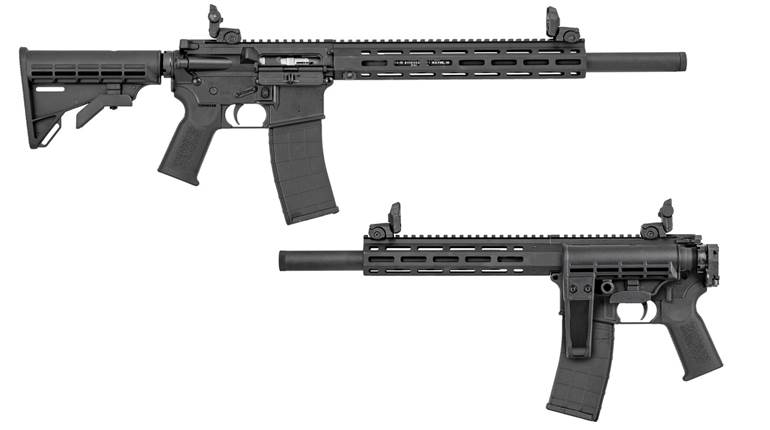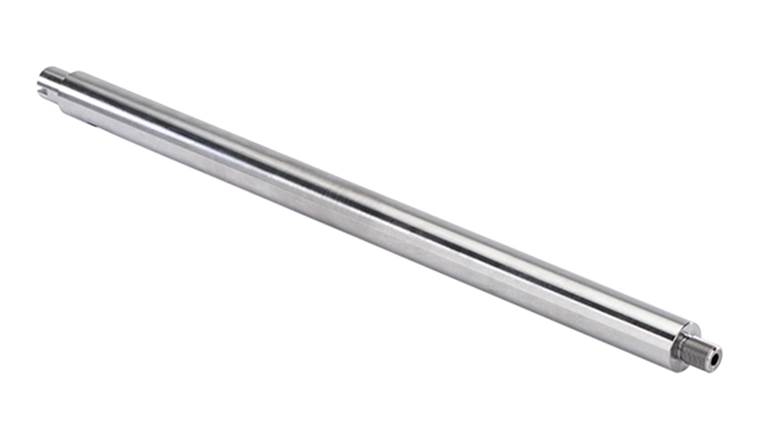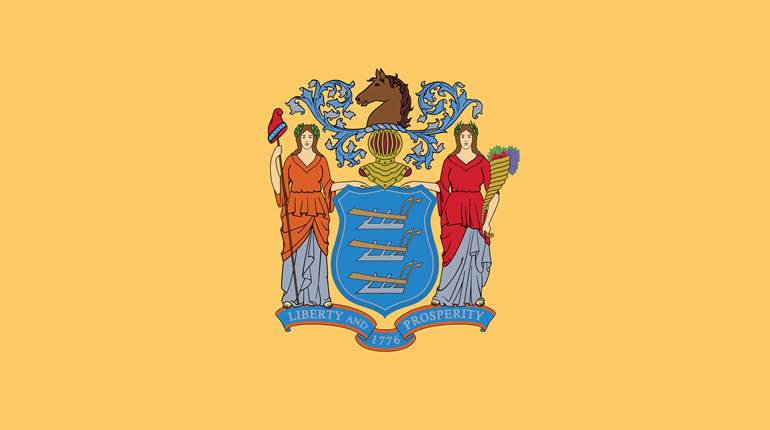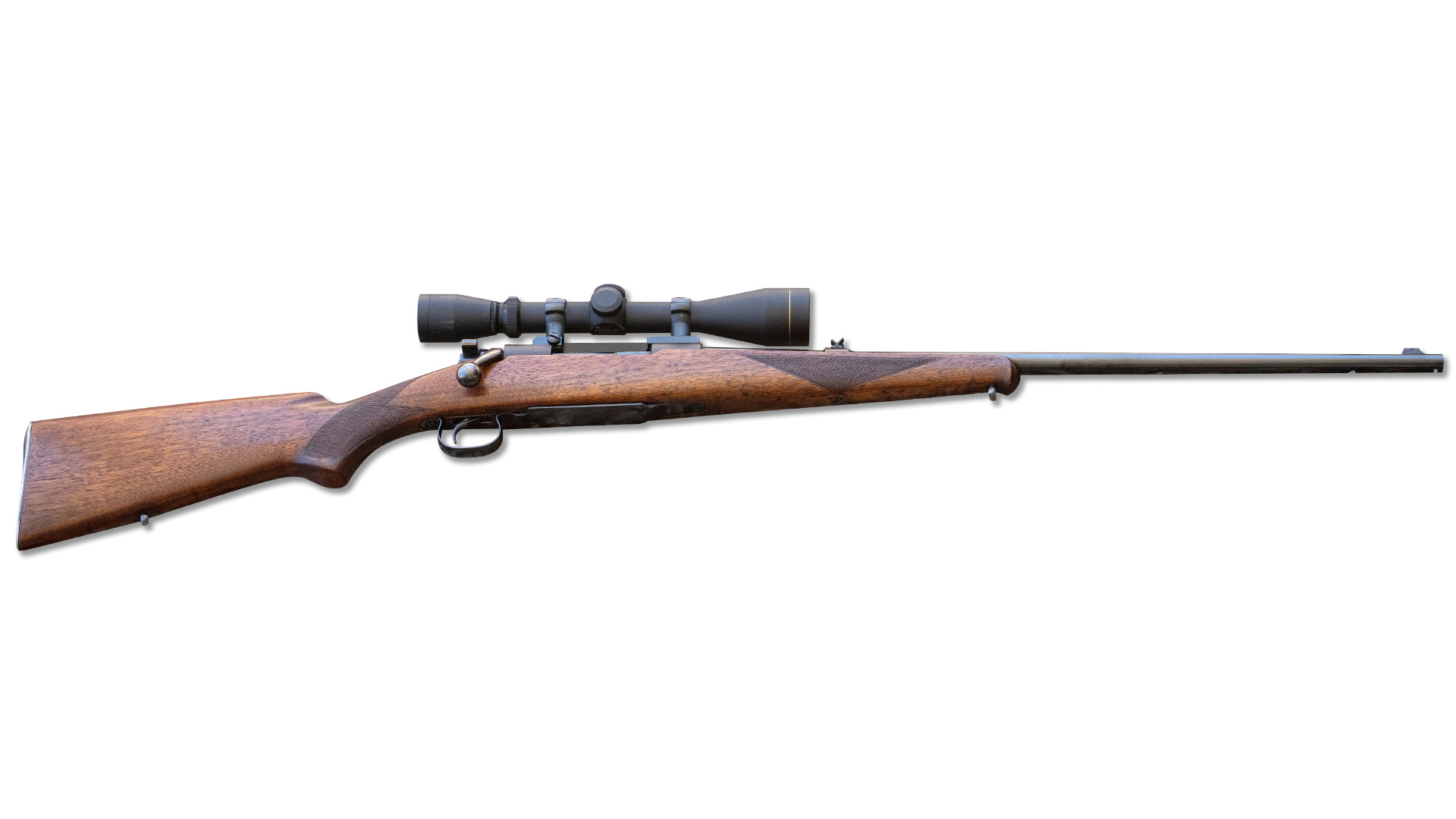
The decade of the 1970s was a time when many iconic handguns were introduced. Kicking it off was the Heckler & Koch VP70, the world’s first polymer-frame pistol. This was followed by a slew of modern designs, many of which are still in production, including the Beretta 92, CZ75 and SIG Sauer P220. The rise of the “Wonder Nines” marked a period when military and law enforcement organizations around the world were transitioning to semi-automatic handguns with double-column magazines and double-action trigger mechanisms. So why is one of the most legendary handguns of the 1970s a revolver that was built specifically for one of the most elite police forces? The answer lies within the unique story of the Manurhin MR73.
 The Manurhin MR73 revolver has developed a legendary reputation as the sidearm of the French Groupe d'Intervention Gendarmerie Nationale (GIGN). Photo credit: Groupe d’Intervention Gendarmerie Nationale
The Manurhin MR73 revolver has developed a legendary reputation as the sidearm of the French Groupe d'Intervention Gendarmerie Nationale (GIGN). Photo credit: Groupe d’Intervention Gendarmerie Nationale
The tale of the MR73 starts with Manufacture de Machines du Haut-Rhin, a company based in the Bourtzwiller neighborhood of the French city of Mulhouse. Established in 1919 as a machinery manufacturer, they entered the ammunition production business in the 1920s, at which time they blended their name into the trademark “Manurhin” (pronounced “man-your-un”). Following World War II, with the Walther factory in ruins and within the Soviet zone of occupation, Manurhin was licensed to make pistols of the PP, PPK and P38 pattern. These handguns would not only be used by police and military forces around the world, they were the first commercial Walthers that many Americans encountered, imported for decades by Interarms. Manurhin would also produce SG 540-series rifles for SIG.
 Still manufactured in France, the MR73 uses a Smith & Wesson style action with hammer-mounted firing pin and hammer block safety.
Still manufactured in France, the MR73 uses a Smith & Wesson style action with hammer-mounted firing pin and hammer block safety.
By the end of the 1960s, European police departments were looking to modernize their arsenals. Among the types of firearms they were looking for was a double-action revolver chambered in .357 Magnum. Manurhin answered with their own design. It was a medium frame, double-action revolver with a swing-out cylinder and full underlug barrel. Though the revolver’s basic layout and internals were based on the Smith & Wesson — with a hammer-mounted firing pin and S&W-style hammer block safety — the company added some unique features.
The revolver used a rebound slide that moved on rollers to reduce friction with an additional roller that contacted a leaf spring. This not only allowed for an exceptionally smooth trigger pull and return with almost no change in trigger pressure, but both the pull and rebound weight could be individually adjusted. An overtravel screw also contributed to the ability to fine tune the trigger pull. Credited to company engineer Gilbert Albert Rene Maillard, the design was granted a U.S. patent in 1976. Production of the revolver began in late 1972 and the model was designated the “MR73.” Early MR73s had a 3” barrel and a fixed rear sight that was a groove in the frame’s top strap, as was common for police revolvers of the day.
 The 4"-barreled Gendarmerie model, as currently sold by Chapuis in Europe, is the MR73's classic police format. Image courtesy of Chapuis Armes.
The 4"-barreled Gendarmerie model, as currently sold by Chapuis in Europe, is the MR73's classic police format. Image courtesy of Chapuis Armes.
The MR73’s story as a provincially manufactured and issued police revolver may have stopped there if it hadn’t been for an elite law enforcement group that was being established at the same time. The early 1970s was a period of increasing international terrorism, with events like the Munich Olympics Massacre prompting European police agencies to update their tactics and firearms. In France, the Groupe d’Intervention Gendarmerie Nationale (GIGN) was formed as a special tactics unit within the country’s Gendarmerie paramilitary national police.
While elite units are most associated with precision rifles and submachine guns, the first item on the GIGN’s shopping list was a handgun which would provide more concealment and maneuverability in confined spaces than a shoulder-fired arm.
 When the newly-formed GIGN looked for a handgun, the MR73 was a natural fit. Photo credit ECP Armee.
When the newly-formed GIGN looked for a handgun, the MR73 was a natural fit. Photo credit ECP Armee.
While a revolver may seem a strange choice at a time when excellent modern semi-automatic handguns were entering the market, the most important requirements for the GIGN were accuracy, reliability, speed of operation and ballistics. In the 1970s, the double-action revolver held a distinct advantage over semi-automatic handguns, in that it could be used in single-action mode for precise longer range shots, with its double-action mode held in reserve for close-range encounters.
The lack of reliably feeding soft-point or hollow-point auto pistol ammunition, as well as the greater ballistic potential of a wheelgun cartridge, also gave the advantage to a revolver. After considering the .44 Magnum and an experimental over-pressure .357 cartridge, the GIGN settled on the standard .357 Magnum. The revolver was the perfect tool for the deliberate and precise nature of the GIGN’s tactical situations, and could be carried concealed, quickly drawn and employed as an offensive arm at distances up to 50 meters (165 feet). Philosophically, the revolver’s limited capacity matched the GIGN’s principle of completing the job with a minimal number of rounds fired.
 The use of the MR73 for close-range work was a basic tenet of GIGN training. Photo credit ECP Armee.
The use of the MR73 for close-range work was a basic tenet of GIGN training. Photo credit ECP Armee.
Not just any revolver would do. While there were several excellent medium-frame .357 Magnum revolvers being manufactured in the 1970s, none could handle the steady diet of full-powered ammunition necessary for the intense training regime of an elite unit (up to several hundred rounds a week). In Manurhin’s factory testing, MR73s showed few signs of wear after nearly 200,000 test rounds, garnering it the reputation as one of the most durable .357 Mag. revolvers ever made.
GIGN approached Manurhin to have the MR73 modified to their tastes. An adjustable rear sight was added and the butt of the frame rounded for better concealment. A 5.25” barrel was found to be the optimal length for accuracy, ballistics and hip holster carry (the GIGN would also issue 3”-barreled models for concealment) and the revolver was given special beavertailed, recoil-controlling grips designed by French grip maker Jacques Trausch. The MR73 would become the emblem of the GIGN and was quickly put to use in several successful hostage rescue missions that the group completed.
 GIGN adopted an 8"-barreled version of the MR73 as a compact, intermediate range sniping system. Photo credit: Groupe d'Intervention Gendarmerie Nationale.
GIGN adopted an 8"-barreled version of the MR73 as a compact, intermediate range sniping system. Photo credit: Groupe d'Intervention Gendarmerie Nationale.
 The "sniper" version of the MR73 used a Harris bipod and an early Bushnell long eye-relief pistol scope. Photo credit: CC BY-SA 4.0 DOMENJOD
The "sniper" version of the MR73 used a Harris bipod and an early Bushnell long eye-relief pistol scope. Photo credit: CC BY-SA 4.0 DOMENJOD
 The MR73 sniper is still in GIGN's arsenal alongside modern precision rifles. Photo credit: Groupe d'Intervention Gendarmerie Nationale.
The MR73 sniper is still in GIGN's arsenal alongside modern precision rifles. Photo credit: Groupe d'Intervention Gendarmerie Nationale.
Not yet satisfied, the GIGN took their unique employment of a revolver and raised it to another level. An 8”-barreled MR73 was equipped with a scope and bipod to be used as an intermediate-range sniping weapon out to 100 meters. Not that the GIGN didn’t already have a precision rifle in the form of the excellent FR F1, but in confined areas, the revolver allowed a shooter to make a precise shot while staying more concealed than if they were using a rifle, and its accuracy and ballistics were still adequate at short ranges. The sniping version MR73 was fitted with an early Bushnell Magnum Phantom 2.5X long eye-relief scope and a Harris bipod attached with a proprietary mount manufactured by Manurhin that clamped to the front of the barrel.
 Though replaced in daily frontline service, the MR73 is still an integral part of GIGN culture and training. Photo credit: Groupe d'Intervention Gendarmerie Nationale.
Though replaced in daily frontline service, the MR73 is still an integral part of GIGN culture and training. Photo credit: Groupe d'Intervention Gendarmerie Nationale.
Though officially replaced in GIGN service by more modern handguns, the MR73 still appears in photos of the GIGN in action. The use of the revolver is also still a part of GIGN training, with each new recruit issued a MR73. It is also still seen in the holsters of law enforcement officers around France and in former French colonies. More than a simple firearm, the MR73 has become itself a symbol of French law enforcement culture. The revolver is featured prominently in films that detail GIGN’s exploits, including the 2011 film "The Assault" (L'Assaut) about the 1994 hijacking of Air France Flight 8969, and the 2019 film "15 Minutes of War" (L'Intervention) about the 1976 Loyada, Djibouti, hostage rescue mission. It appears in nearly every French police drama, including a 2008 film entitled "MR73."
 The MR73 was also made in a target format, such as this Match .38 Special. Image courtesy of Chapuis Armes.
The MR73 was also made in a target format, such as this Match .38 Special. Image courtesy of Chapuis Armes.
Manurhin would go on to produce other revolver designs, including the MR88, MR93 and MR96, as well as .38 Spl., .32 S&W Long and .22 LR chambered match versions of the MR73. The rights to these designs were transferred to fellow French arms maker Chapuis Armes in 1998 when Manufacture du Haut Rhin - Manurhin exited the firearms business (they continue to produce ammunition manufacturing equipment). Chapuis, known for their high-end hunting rifles and sporting shotguns, moved the original manufacturing equipment to their location in Saint Bonnet Le Chateau.
Their process of manufacturing the MR73 starts with a frame forging and billet cylinder blank that are machined on five-axis CNC equipment. Barrels are cold hammer-forged and the chambers of the cylinders roller burnished. Final fitting and finishing is still done by hand and the revolvers are proof tested and then accuracy tested to confirm that they meet the company’s standard of placing six shots within the 10 ring on an ISSF C50 target at 25 meters (approximately 1.97” at 27 yards).
 MR73 revolvers are still hand fitted at the Chapuis factory. Image courtesy of Chapuis Armes.
MR73 revolvers are still hand fitted at the Chapuis factory. Image courtesy of Chapuis Armes.
 Each revolver is proof tested and fired for accuracy before leaving the factory. Image courtesy of Chapuis Armes.
Each revolver is proof tested and fired for accuracy before leaving the factory. Image courtesy of Chapuis Armes.
In the U.S., the MR73 is legendary and, until recently, exclusive. Since the 1980s, Manurhin revolvers have been imported into this country in small batches by boutique distributors or even as used police surplus. That changed in 2019 when the Manurhin brand came under the umbrella of Beretta Holdings, a consortium that includes other iconic firearms brands, including Uberti, Benelli, Holland & Holland and SAKO.
Beretta now imports the revolvers into the U.S. Two basic models are offered, which differ in their sights (Gendarmerie models have a rounded front blade for snap-free draws from a holster) and barrel lengths. Sport models are available with 3”, 4”, 5.25”, 6” and 8” barrels, while Gendarmerie models can be had with 3” or 4” barrels. Both models have Trausch-style rubber grips and adjustable sights, and have an MSRP of $3,799, with the exception of the 8” barreled Sport model, which retails for $4,099.
 The MR73 is currently imported into the U.S. by Beretta in two formats, the Sport (top) and Gendarmerie (bottom). Images courtesy of Beretta USA.
The MR73 is currently imported into the U.S. by Beretta in two formats, the Sport (top) and Gendarmerie (bottom). Images courtesy of Beretta USA.
In 2023, to celebrate a half century of MR73 production, Beretta offered a 50th Anniversary Edition MR73. The Anniversary Edition differs from their standard offerings in a few key areas. The 5.25” Sport-length barrel is custom engraved on the left side with the words “MR73 Heritage 357 Magnum”. Grips, produced by Chapuis based on an original Nill design, are oil-finished black walnut with finger grooves, a stippled finish and an embedded Manurhin logo.
The LPA-style adjustable sights have contrasting fiber optic inserts in both front and rear. The revolver ships in a Negrini case, whose velvet lining declares “MR 73 Heritage. 1973. 2023. 50eme Anniversaire.” Seventy-three anniversary models will be made for the French market, along with 73 examples for the international market, 50 of which were imported into the U.S.
 To celebrate 50 years of MR73 production, Chapuis is making a limited-edition anniversary model.
To celebrate 50 years of MR73 production, Chapuis is making a limited-edition anniversary model.
 The MR73 50th Anniversary Edition comes cased with a spare 9 mm Luger cylinder.
The MR73 50th Anniversary Edition comes cased with a spare 9 mm Luger cylinder.
 The Anniversary Edition has the same adjustable LPA-style sights as the MR73 Sport model, with the addition of fiber optic inserts in front and rear sights.
The Anniversary Edition has the same adjustable LPA-style sights as the MR73 Sport model, with the addition of fiber optic inserts in front and rear sights.
From the early stages of MR73 production, the company offered an optional spare cylinder chambered in 9 mm Luger. The Anniversary Edition MR73 ships with such a cylinder. The original Maillard-designed system that used a spring on each extractor cut-out to allow for the rimless 9 mm Luger cartridges to be ejected has been replaced by a simple “moon clip” system.
Cartridges are loaded into the clips and inserted together into the cylinder. The extractor removes the empty cases intact on the clip. Four clips are supplied with each revolver. To swap cylinders, remove the pivot stop screw, which passes through the front of the sideplate, allowing the cylinder and crane assembly to be removed from the frame. With the assembly out, the crane can be removed and switched to the other cylinder. The assembly is placed back in the frame and the screw re-installed. The revolver ships with the proofing documentation for each chamber of both cylinders.
 The Anniversary Edition's 9 mm Luger cylinder uses a "full moon" clip system to allow for loading and unloading the rimless auto pistol cartridges.
The Anniversary Edition's 9 mm Luger cylinder uses a "full moon" clip system to allow for loading and unloading the rimless auto pistol cartridges.
 The moon clips act like speedloaders, allowing all six cartridges to be loaded at once.
The moon clips act like speedloaders, allowing all six cartridges to be loaded at once.
Snap the latches to open the MR73’s case, and you lift the lid on Old World gun making. With Cerakote, DLC and anodizing the contemporary firearm finishes of choice, it’s easy to forget the luxuriousness of deep, high-polish bluing or what Beretta calls “Acier Noir Brillant Polyglass Mirror Finish.” This is complemented by the straw coloring of the MR73’s hammer, trigger, ejector rod and cylinder release button, a result of the tempering process. The stippled wood grips give a 1970s retro look and feel.
 On the range, the legendary trigger pull and accuracy of the MR73 are quickly apparent.
On the range, the legendary trigger pull and accuracy of the MR73 are quickly apparent.
On the range, the 5.25” barrel length shines, just as the GIGN discovered, as the perfect balance between carriability in a hip holster and shootability. In American parlance, the MR73 is sized between a Smith & Wesson K-frame and L-frame. Dimensions are close enough to a K-frame that some holsters will work for the MR73, as well as K-frame-sized speedloaders, such as the HKS 10.
 From a bench rest, the MR73 provided the accuracy guaranteed by the factory with all types of ammunition we tested.
From a bench rest, the MR73 provided the accuracy guaranteed by the factory with all types of ammunition we tested.

We used one cartridge type each of .357 Mag., .38 Spl. and 9 mm Luger, for official ballistics and accuracy testing, all of which the MR73 handled with aplomb. Though the measured trigger pull weights seem heavy on paper, due to the smoothness and consistency of the trigger, I didn’t feel the need to adjust it from the factory settings. The single-action trigger breaks crisply with zero overtravel and the double-action pull exhibits the smoothness and constancy that MR73 revolvers are legendary for.
 The MR73's trigger has three adjustments to fine tune the pull - mainspring and rebound weight and overtravel.
The MR73's trigger has three adjustments to fine tune the pull - mainspring and rebound weight and overtravel.

Chapuis produces numerous Manurhin models not currently imported into the U.S., such as this MR88 Defense. Image courtesy of Chapuis Armes.
As part of the Beretta family, Manurhin revolvers will likely now have a permanent presence in the U.S. market. Though it comes with an “if you have to ask” price, the cost of the MR73 reflects the materials and handwork that goes into each one. Chapuis is currently manufacturing MR73s in competition models, as well as MR32 and M38 Match revolvers. Additionally, they are making an all stainless steel MR88, a more basic design that retails for $1,500 less than the MR73 in European markets. If the MR73 proves popular in Beretta’s U.S. lineup, it’s possible that more MR73 options and additional models of Manurhin revolvers may come stateside in the future. With performance that matches its reputation, the Manurhin MR73, is a case of the uniquely French approach to firearms and their use resulting in an unlikely legend.





































